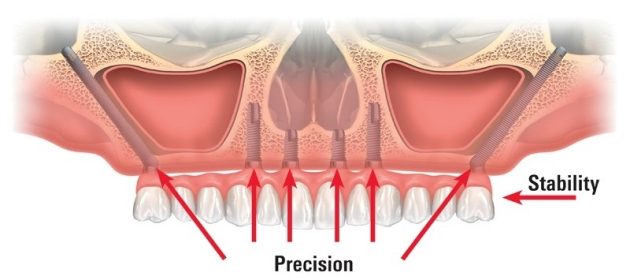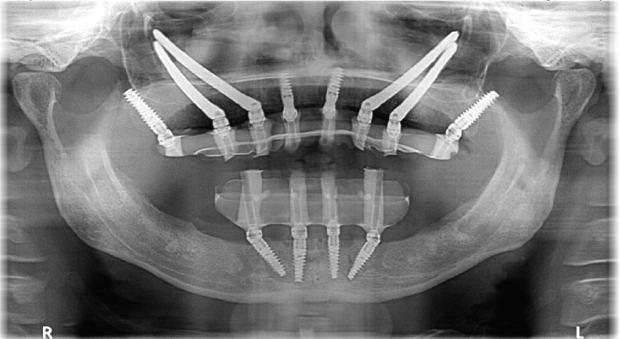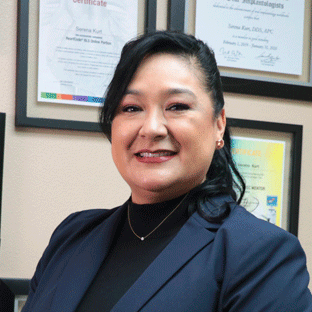There are different ways in which it is possible to install dental implants in a person’s mouth. There is a very well-known procedure of getting small screw-like implants inserted in the low or upper jaw. The more unconventional method consists of getting much longer implants placed in the cheekbone, also known as Zygomatic dental implants.
It is a procedure designed specifically for people who don’t have enough bone structure to get the typical implant surgery, hence why they are quite unusual.
Zygomatic implants consist of less invasive intervention and fewer clinic visits. Besides, patients don’t have to go through bone grafting (where dentists have to take bone from other areas of your body to strengthen and give volume to your jaw), which can add significant time and cost to treatment.
Thanks to this solution, those patients who were told that they’re not good candidates for implants and had to settle for dentures now have another alternative to get brand new teeth.
But, How Exactly Are Zygomatic Implants?

Let’s start by saying that these implants will function just like the regular ones. However, at first, they might seem a bit scary since they are way longer than traditional implants, but have in mind that they are designed to perfectly fit the space in your cheekbone so they can create a secure foundation for the new teeth.
For you to get a better idea of how Zygomatic implants work, we’ll give you a short but clear description of its components:
- Implant: this type of implant is made out of titanium, a biocompatible metal with the human bone structure. It looks similar to a screw, and its length goes from 30.0 to 52.5 millimeters. It goes below the gums, and its primary purpose is to fuse with the bone of your cheekbone to imitate the strong base of a natural tooth root.
- Abutment: This is a piece that plays as a connector, and it fastens the arch to the implants. They can be angled in order to attach the slanting implants to artificial teeth or dentures.
- Arch: the last and a complementary part of Zygomatic implants; these are the prosthesis or artificial teeth that will function just as natural ones. Depending on the material, which generally would be Zirconia, arches can last for several years if they appropriately take care of them.
Candidates for Zygomatic Implants and Care Recommendations

Before the procedure takes place, the dentist will first have to diagnose what the patient needs. In this case, Zygomatic implants work as an effective alternative to rehabilitate patients who may have undergone surgeries in the maxilla areas. This could be due to cancer or severe accidents; these patients have severe surgical sequelae, possibly because surgeries removed part of the palate. After the incident, the patient isn’t capable of chewing, swallowing, or even talking.
As mentioned before, Zygomatic implants help rehabilitate patients who do not have any bone structure to work with; Implants can actually be set in place in one visit and will take three to five days for the after-effects ease off. These can come in the form of swelling, bruising, and bleeding.
The implants will then have to fuse with the cheekbones, which is a process that takes around five to six months to stabilize fully. While it happens, the patients need to take care, so the following tips can help prevent any discomfort and adequately care for oral health:
- Try not to disturb the area and brush gently.
- Avoid using toothpaste for about two to four days. Try dipping your toothbrush into water or mouthwash.
- Avoid sneezing like you usually would, and opt for sneezing with your mouth open for about two weeks. You should also avoid blowing your nose for the same amount of time.
- Do not smoke, as this can delay healing or cause worse problems.
After this, the dentist will have to place the dentures, and the patient’s smile will be good as new. The Zygomatic technique allows patients who would ordinarily require additional surgeries to obtain implants much sooner.
These implants restore the patient’s smile and improve daily activities like speaking or chewing. After the operation occurs, the patient must follow a hygiene routine to ensure their new beautiful teeth don’t get damaged and can last for a long, long time.
What Are the Risks That Come With Zygomatic Implants?
If we talk about critical risks, there are just a few that can potentially harm your oral health, like toothaches or bruising.
The main complication that may arise during zygomatic implants is sinusitis. According to specialists, sinusitis may be apparent even years after the operation. But, in very few cases, there can be complications due to poor dental practices.
Other complications may include the following:
- Nausea can occur and be quite troublesome and very uncommon after surgeries like dental implants. The leading cause of nausea or sickness maybe because of the patient’s medications; dentists recommend eating a small portion of food with the pill and generous amounts of water. Even though medicine is welcome, reducing the number of pain medications can indeed help reduce the sensation.
- Strenuous activities like lifting heavy objects can also increment toothaches as the blood flow around the body can pulse around the surgical area generating an unbearable painful feeling.
- Pain is quite common after any surgery or operation around the body and can be quite unpleasant; that is why dentists recommend not moving much and taking strolls around the neighborhood or relaxing at home watching a movie.
- Excessive bleeding is expected after the procedure takes place but should subside after a couple of days. The patient should expect no bleeding at all after a week, but you can use gauzes and place it over the area for about half an hour. If the bleeding doesn’t stop, call your dental office and seek help from your dentist.
- Bruising or swelling goes hand and hand with oral surgery but can be avoided with cold products like a bag of frozen peas.
But some products can reduce these symptoms like:
- Prescribed medications by your dentist
- Mouthwash can prevent bacteria from generating around the surgical area
Remember, every case is unique, so most likely, not all people will have the same complications. If you happen to have severe bone loss, ask your dentist about Zygomatic implants. Depending on their evaluation, they’ll be able to determine if that is the best option for you and let you know what you can expect from the full procedure.
As you can see, there is always a great way to get dental implants in San Diego. If you have more questions about this or other procedures, call your dentist in Clairemont. We are ready to help you.




Leave a Reply